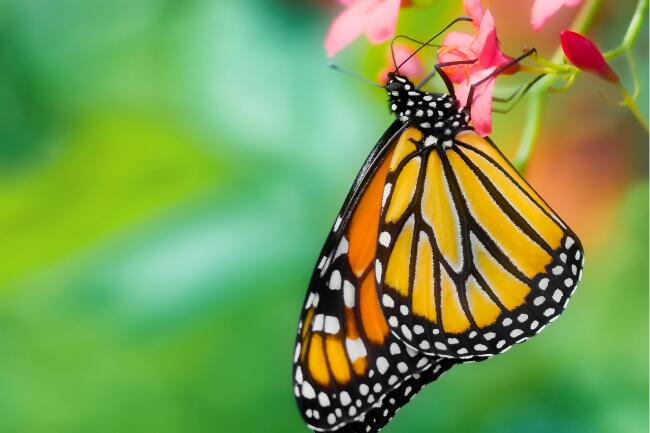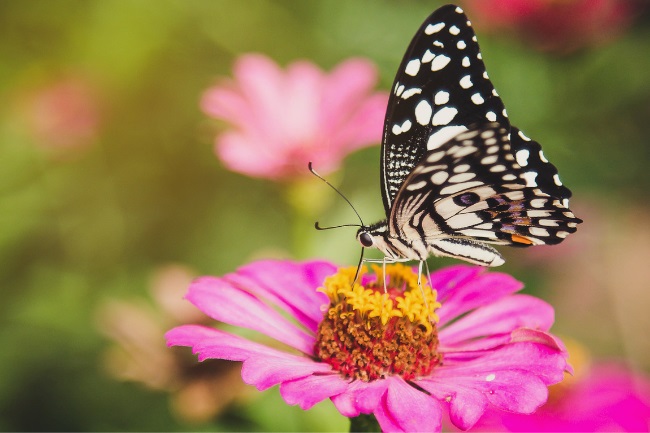Butterflies have chemical sensors in their feet that allow them to taste the objects they land on. This helps them to know when nectar is present and choose the right plant to lay their eggs on.
Contents
How do butterflies eat?

To humans eating and tasting very much go hand in hand. This is because our taste buds are located on our tongue, and therefore it’s while we eat that we pick up the chemicals that tell us what we’re tasting. As well as the sensors in our mouths we also have additional sensors in our nose, which can help to collect more data on what we’re eating.
For butterflies, however, things are very different. They eat with their proboscis. This is a long thin tube they use to suck up their food. Most of the time the proboscis is folded up under the body, only to be unfurled when food is available.
Though often referred to as the butterfly’s tongue, the proboscis is actually the butterfly’s mouth. Unlike us butterflies do not have a tongue, or even teeth. Luckily their food, nectar, comes in a liquid form and can therefore be slurped up without requiring chewing.
Without a tongue, or other sensory organs within their proboscis, butterflies have to find another way of collecting information on what they are about to eat.
Also read: How & What do Cicadas Eat? (Eating Habits Explained)
Do butterflies taste with their feet?

If asked to point out an important part of the body for our senses the common options would probably be the eyes, mouth and ears. One part of the body we probably wouldn’t think of is our feet.
Yet, for butterflies their sensory organs are arranged a little differently from ours. Chemoreceptors are sensory organs that detect the presence of certain chemicals. In humans these are located in the nose and on the tastebuds.
| Butterfly Species | Sensory Organs | Tasting Mechanisms |
|---|---|---|
| Monarch Butterfly | Feet, Proboscis | Taste receptors on feet and proboscis |
| Painted Lady Butterfly | Feet, Proboscis, Antennae | Taste receptors on feet, proboscis, and antennae |
| Swallowtail Butterfly | Feet, Proboscis, Antennae | Taste receptors on feet, proboscis, and antennae |
| Blue Morpho Butterfly | Feet, Proboscis, Antennae | Taste receptors on feet, proboscis, and antennae |
Each sensor is activated only by its corresponding chemical. Once detected by the sensor, a signal heads to the brain to inform it that that particular chemical has been recorded. In butterflies these sensors are located largely in their antenna, legs and feet.
The antennae are very important sensory organs in a butterfly. They can pick up pheromones released by the opposite sex in order to locate a mate. They are also used to pick up information on where food might be found.
While the antannae tend to be used to pick up chemicals being blown around by the wind, the sensor’s located on the feet do so more by coming into contact with the surface of a leaf or a flower petal.
Amazingly a butterflies feet can detect a range of chemicals. With a little tap here and there the butterfly can decide if it’s landed on a tasty source of nectar or simply on a watery leaf. The butterflies don’t just use this superpower to know when they can take a nice long drink, they also use it to choose food for their young.
By landing on a leaf a butterfly can taste if they have chosen a plant their caterpillars would want to eat. They can even use their feet to choose which of the suitable plants they might deem worthy of their young.
This is an incredibly important task as once their caterpillars hatch out of their eggs they need to get to eating very quickly. Being stranded on the wrong plant could be a death sentence to them. Some butterflies, like the green hairstreak, are known to dance a little jig as they turn round, tasting the leaf they are stood on with their feet.
Monarch butterflies, are extra careful, ensuring they have tested a leaf with each of their feet before they begin laying their eggs, in order to be extra sure. The sensors may not just be on their feet, with some butterflies having sensory organs going all the way up their legs.
The thought of these ‘tasting feet’ can be even more unpleasant when you consider that some butterflies land on the faeces of other animals, sucking up the liquidy juices to provide themselves with certain minerals they lack.
Also read: Do Butterflies Mate for Life? Eternal Love or…
A human saltlick
When all is said and done the butterfly’s way of dipping its toes in the flavoursome water before it takes a sip can come across as rather strange. What might seem even stranger is that when a butterfly chooses to alight on your skin it may be because it’s tasting for the salts we exude in our sweat.
It may seem like an unpleasant consequence of heat to us but to the butterfly, those salts may just be tasty enough to take a great big slurp from. So next time a butterfly lands on you remember that you may just be a perfect butterfly saltlick.

